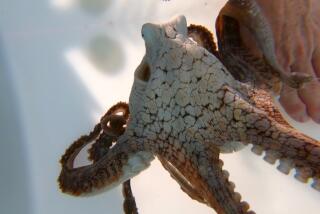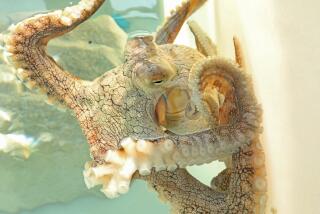A Harsh and Wonderful Lesson : Octopus Births, Mother’s Death Play Out Tale
A story of the beginning--and the end--of life is unfolding before schoolchildren studying oceanography at the Orange County Marine Institute in Dana Point.
The tale is being acted out by a small female octopus who for the past five weeks has been laying her eggs--thousands of them--and who, when she is done, will die by the design of nature.
The octopus, only about 3 feet long with all her tentacles extended, was brought in last year by “a commercial lobster fisherman who found her having a lobster dinner in one of his traps,” said Harry Helling, the institute’s director of education.
The Last Chapter
Now 2 years old, she has gone under the rocks to act out the last chapter of her life.
“You can’t see much of her because most of the time she’s hiding under the rocks in a display tank,” Helling said. But under those rocks she has been keeping so busy that she hasn’t had time to eat for the last two months.
“Five weeks ago, she started laying eggs,” said Linda Blanchard, director of the institute’s marine lab. “Since then, she has spent all her time tending the eggs, keeping them clean, making sure they aren’t tangled up, because they come out like little bunches of grapes on a long, thread-like cord.”
And the eggs have been hatching at a breathtaking rate, thousands and thousands of them. The babies’ bodies are about twice the size a pinhead, with tiny tentacles hanging down, complete with suction disks. Swimming in the clear water of the tank, dancing slowly up and down, they appear as whitish, almost translucent dots.
“Small as they are, they already have their little ink sacs (octopuses squirt ink to hide from enemies) and they have the ability to change color as a camouflage protection,” Blanchard said, scooping one from the aquarium and putting it in a dark blue plastic bowl, where it immediately changed from whitish to almost black.
Blanchard said that so far, she has taken several bucketfuls--probably between 5,000 and 10,000 of the small creatures--and returned them to the ocean. She expects the final count to be anywhere from 200,000 to 250,000. But it has been estimated that in the open sea among myriad predators, the survival rate of baby octopuses is less than 1%.
Children from schools throughout the county and California, enrolled for special courses at the Marine Institute, study the mother octopus and her little creatures in the tank as well as through a microscope, which magnifies and projects their images on a small computer screen.
“We haven’t given her a name,” Helling said, “and we’ve discouraged the kids from doing that because it tends to create a sort of close relationship, and we know, and the kids know, that in the nature of her kind, once all her eggs are laid, she’ll die.”
Three kinds of octopuses, all rather small with tentacle spreads of two or three feet, inhabit the waters off Orange County: Octopus binaculoides, or “two-spot,” which is the species at the Marine Institute; Octopus rubescens, or “red octopus,’ and Octopus microtyrsis, a pigmy less than a foot in breadth.
Farther north, starting at about Monterey, they tend to get larger, according to John Grant, a marine biologist for the state Department of Fish and Game. A monster called Octopus dofleini, reaching a size of 30 feet, occurs off British Columbia, Grant said.
Because octopus is a delicacy in many Asian countries, there were some efforts to start commercial fisheries in California in the late 1970s, but with little success.
Grant said the reproduction process among octopuses is a “very impersonal” affair.
“The male grows a modified arm, or tentacle, called a hectocotylus, with a package of sperm attached,” Grant explained. “He goes over, drops off the package and walks away, leaving her to fertilize and care for the eggs.”
THE TWO-SPOT OCTOPUS
Name: Octopus Binaculoides (also ‘two-spot’)
Size: two-to-three feet tentacle spread
Habitat: Inshore waters of Southern California; lives in holes or crevices on rocky bottom
Procreation: Female lays several thousand eggs at a time up to as many as 200,000 to 250,000 nearly transparent eggs that hatch in a few weeks
Food: Clams, crabs, lobsters, mussels and other shellfish
Notes: Considered a delicacy in many areas; has three hearts; no bones or inside shell
Source: World Book Encyclopedia


